Potrebujeme váš súhlas na využitie jednotlivých dát, aby sa vám okrem iného mohli ukazovať informácie týkajúce sa vašich záujmov. Súhlas udelíte kliknutím na tlačidlo „OK“.
ASTM D5470-12
Standard Test Method for Thermal Transmission Properties of Thermally Conductive Electrical Insulation Materials
Automaticky preložený názov:
Štandardná skúšobná metóda pre prestupu tepla vlastností tepelne vodivý elektrických izolačných materiálov
NORMA vydaná dňa 1.1.2012
Informácie o norme:
Označenie normy: ASTM D5470-12
Poznámka: NEPLATNÁ
Dátum vydania normy: 1.1.2012
Kód tovaru: NS-31355
Počet strán: 6
Približná hmotnosť: 18 g (0.04 libier)
Krajina: Americká technická norma
Kategória: Technické normy ASTM
Kategórie - podobné normy:
Anotácia textu normy ASTM D5470-12 :
Keywords:
apparent thermal conductivity, guarded heater method, thermal conductivity, thermal impedance, thermally conductive electrical insulation, Guarded heater method, Roiseland method, Apparent thermal conductivity, Electrical insulating solids, Thermal conductance/conductivity, Thermal impedance, Thermal insulating materials (electrical), ICS Number Code 29.035.01 (Insulating materials in general)
Doplňujúce informácie
| Significance and Use | ||||||
|
This standard measures the steady state thermal impedance of electrical insulating materials used to enhance heat transfer in electrical and electronic applications. This standard is especially useful for measuring thermal transmission properties of specimens that are either too thin or have insufficient mechanical stability to allow placement of temperature sensors in the specimen as in Test Method E1225. This standard imposes an idealized heat flow pattern and specifies an average specimen test temperature. The thermal impedances thus measured cannot be directly applied to most practical applications where these required uniform, parallel heat conduction conditions do not exist. This standard is useful for measuring the thermal impedance of the following material types. Type I—Viscous liquids that exhibit unlimited deformation when a stress is applied. These include liquid compounds such as greases, pastes, and phase change materials. These materials exhibit no evidence of elastic behavior or the tendency to return to initial shape after deflection stresses are removed. Type II—Viscoelastic solids where stresses of deformation are ultimately balanced by internal material stresses thus limiting further deformation. Examples include gels, soft, and hard rubbers. These materials exhibit linear elastic properties with significant deflection relative to material thickness. Type III—Elastic solids which exhibit negligible deflection. Examples include ceramics, metals, and some types of plastics. The apparent thermal conductivity of a specimen can be calculated from the measured thermal impedance and measured specimen thickness if the interfacial thermal resistance is insignificantly small (nominally less than 1 %) compared to the thermal resistance of the specimen. The apparent thermal conductivity of a sample material can be accurately determined by excluding the interfacial thermal resistance. This is accomplished by measuring the thermal impedance of different thicknesses of the material under test and plotting thermal impedance versus thickness. The inverse of the slope of the resulting straight line is the apparent thermal conductivity. The intercept at zero thickness is the sum of the contact resistances at the two surfaces. The contact resistance can be reduced by applying thermal grease or oil to the test surfaces of rigid test specimens (Type III). |
||||||
| 1. Scope | ||||||
|
1.1 This standard covers a test method for measurement of thermal impedance and calculation of an apparent thermal conductivity for thermally conductive electrical insulation materials ranging from liquid compounds to hard solid materials. 1.2 The term “thermal conductivity” applies only to homogeneous materials. Thermally conductive electrical insulating materials are usually heterogeneous and to avoid confusion this test method uses “apparent thermal conductivity” for determining thermal transmission properties of both homogeneous and heterogeneous materials. 1.3 The values stated in SI units are to be regarded as standard. 1.4 This standard does not purport to address all of the safety concerns, if any, associated with its use. It is the responsibility of the user of this standard to establish appropriate safety and health practices and determine the applicability of regulatory limitations prior to use. |
||||||
| 2. Referenced Documents | ||||||
|
Podobné normy:
Historická
1.4.2014
Historická
1.10.2006
Historická
1.10.2009
Historická
1.11.2012
Historická
1.3.2013
Historická
1.1.2012


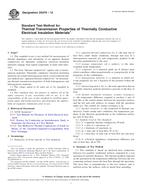
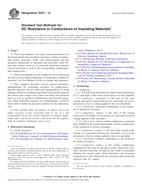 ASTM D257-14
ASTM D257-14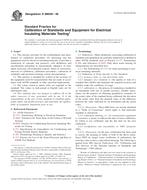 ASTM D2865M-06
ASTM D2865M-06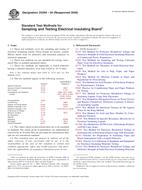 ASTM D3394-94(2009)..
ASTM D3394-94(2009)..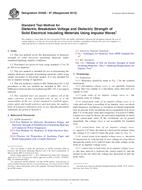 ASTM D3426-97(2012)..
ASTM D3426-97(2012)..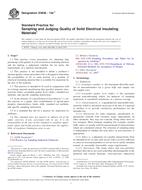 ASTM D3636-13ae1..
ASTM D3636-13ae1..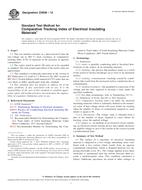 ASTM D3638-12
ASTM D3638-12
 Cookies
Cookies
